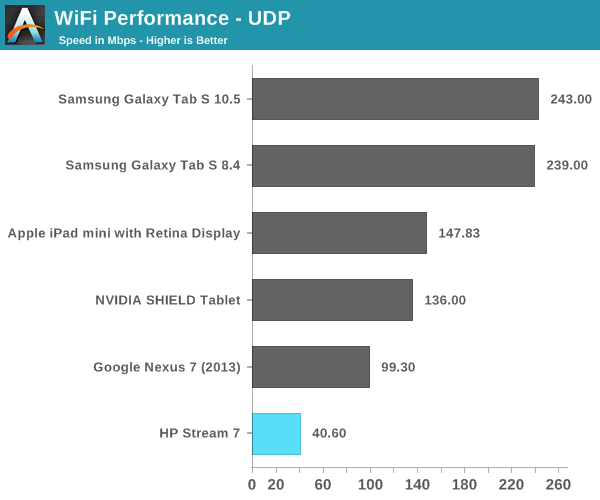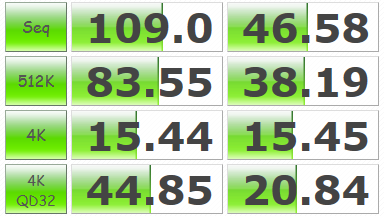HP Stream 7 Review: A $119 Windows Tablet
by Brandon Chester on December 19, 2014 8:00 AM ESTCamera
It looks like including a camera is now a requirement for pretty much any device, and so even the Stream 7 has a front-facing and a rear-facing camera. In the Windows device manager, the front camera identifies itself as "Camera Sensor GC310". I haven't been able to find any information about it, but the image quality leads me to believe that it may be best for people to not know where it came from. The rear camera idenitifes itself as HM2056, which I was able to find information about. It's made by a company called Himax Imaging, and if you haven't heard of them it's okay, because I hadn't either. It's a 2MP 1/5" sensor, which translates to 1.75 micron pixels. It has no auto focus, and that combined with the specifications leads me to believe that this is normally intended to be a front-facing sensor.
As you can see, the output is really bad. The text on the back of the books is illegible, most detail is lost, and there's noise everywhere. It's just honestly not a good camera, and it's something I would only use as a last resort. It's somewhat annoying that HP felt the need to even put a rear camera on the Stream 7, as it adds to the BOM and the money could have been better used on something like a larger battery.
NAND
I mentioned earlier that the Stream 7 doesn't even have enough storage to fit PCMark 8 and some of the other benchmarks we use. Out of the box, you get around 18.5GB free. This means that we can't run our typical Windows storage benchmarks, so I've used CrystalDiskMark to get an idea of how the storage performs.
I wouldn't try making direct comparisons between this and our storage benchmarks on Android and iOS, but it's still able to give you an idea of what you can expect. The Stream 7 uses Samsung's MGB4GC eMMC solution, so we can't expect the same storage performance that you get from Windows devices with a full blown SSD. The read and write performance ends up being pretty good for an eMMC solution, although I'm suspicious of the 4k random write result considering how even the best eMMC solutions we've seen in Android and iOS tablets top out around 3MB/s.
WiFi
The HP Stream 7 uses a Realtek RTL8723BS solution for WiFi and Bluetooth. This is a single spatial stream 802.11n part, with no 5GHz support and only 20MHz channel width. That means that we're dealing with a theoretical maximum speed of 72Mbps. In real world use, it's quite a bit less, as you can see below.

Again, at $119 this is expected and can be excused. Faster WiFi would be nicer, but it's not free. My only complaint about this speed in the real world is that the slow WiFi makes it difficult to move large files over the network onto the Stream 7. This wouldn't be an issue if these Windows tablets allowed you to directly move files to them from another computer over USB, but they don't. I've also encountered issues with the WiFi disconnecting intermittently, which is incredibly frustrating when it means you have to begin transferring a large video from the beginning. I've contacted HP about this to see if they're aware of this issue, as I've seen complaints about it from other users, but I haven't received a response.
Misc
I am unfortunately not equipped to do objective audio testing on the Stream 7. It uses Realtek's audio codec, and so it isn't likely to be anything exceptional. The bottom mono speaker is adequate; there's not much to be said about it. Unfortunately, everything comes crashing down when you try to use the 3.5mm jack. Even if the Stream 7 had the best audio solution in the world, it would be crippled by this defect that I cannot believe made it to production.
Essentially, the 3.5mm jack has a great deal of noise and static, and it makes it effectively unusable. I have confirmed this with two other owners, and there are complaints about it on the web. It's likely that there's an insufficient amount of shielding for the audio port and PCB connections, and it's extremely disappointing. With its support for all the great video players on Windows, the Stream 7 could have been an inexpensive and powerful video player. But unless you're going to use the built-in speaker or Bluetooth headphones/speakers, there's no way to listen to audio on this tablet. When I reached out to HP about the WiFi connection issues I also asked about this, but again I haven't received a response.


















157 Comments
View All Comments
ClockworkPirate - Saturday, December 20, 2014 - link
The Stream 8 also has an LTE radio. For that reason alone I'm considering returning the 7 I got for my brother... Free 200MB/mo from T-Mobile is just so tempting.Spectrophobic - Saturday, December 20, 2014 - link
Oh yeah, forgot about that. That could be a good point for several people. But for myself, who only uses a tablet at school or at home, it isn't a big deal.damianrobertjones - Friday, December 19, 2014 - link
"microSDHC (Up to 32GB)"It's odd that they state that... It WILL work with the 64GB cards and, probably, 128GB.
Brandon Chester - Friday, December 19, 2014 - link
Yeah I would expect it would go higher, but I don't have a 64GB card to test and I don't want to ruin someone's day by having them buy this and a MicroSD that ends up not working.cruzinforit - Friday, December 19, 2014 - link
Brandon- is that a copy of Kisses, sighs and cherryblossom pink I spy sitting next to your Mami figurine?Brandon Chester - Friday, December 19, 2014 - link
No.azazel1024 - Friday, December 19, 2014 - link
For the eMMC performance, I don't know why you'd be super surprised. I've run a couple of different benchmarks on my Asus T100 with a Sandisk SEM64 in it (64GB eMMC) and I get around 20MB/sec read and write 4k numbers. About 40MB/sec sequential write and 105MB/sec sequential read. This is both when I got it new and I ran the test a few weeks ago to see how TRIM had been keeping up over the last year that I've owned it. I got roughly the same numbers I did before (using ATTO and Crystal disk both). I'd imagine that'll fall apart quickly, but it is pretty good with random/small file performance in both testing and real usage. Its just that the sequential numbers are kind of sucky on the eMMC in the Asus T100.Of course that says nothing about the HP Slate 7, I am just saying I don't think the numbers are necessarily suspicious.
On a different note, anyone here when Airmont/Cherry Trail might finally be dropping?
azazel1024 - Friday, December 19, 2014 - link
Also, Brandon, on the storage utilization, you mention that there is missing space you have a hard time tracking down. What is shown under the settings for usage doesn't take in to account things like the hiberfile.sys (hibernation file, which is generally equal to the installed RAM base), page file or any recovery/restore partitions.Brandon Chester - Friday, December 19, 2014 - link
I tried to take that into account based on what the tablet originally had free before I did anything with it. There's just stuff that accumulates like files left in Program Files after you uninstall a desktop app, and files stored in Appdata that don't get deleted.Death666Angel - Sunday, December 21, 2014 - link
I take my windows file system over any android or iOS stuff any day of the week. I know more about the things on my 7 drives in my windows desktop than I do about what is on my 16GB smartphone/tablet.